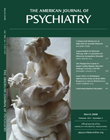This aptly named self-help book is one of a series of accessible firsthand accounts of mental illness. The patient/author, Snyder, presents his experiences in first person in sections entitled “My Story,” followed by sections jointly written with Gur entitled “The Big Picture,” which are written in a voice that varies from the impersonal to the second person “you.” Wasmer Andrews, a journalist, adds case examples from patient interviews. A section containing 12 paintings by “people who have or may have had schizophrenia” is included without comment. Mostly outsider, naive primitivist, or expressionist, the paintings do not specifically reflect the syndrome (as, for example, Silvano Arieti did in his older collection
[1] ).
Mr. Snyder’s case history, which I found winning in its detailed revelations, features paranoid ideas of reference and difficulty with focus and has a happy outcome. Although unable to complete college, with treatment Mr. Snyder is able to train and work as a database administrator. Originally, he suspects people are spying on him, because while typing on his computer the cursor moves without his touching the mouse. I am sympathetic, as at the time my laptop also had this keyboarding defect, which was included in a class action suit against a prominent computer purveyor. Mr. Snyder endorses antipsychotic medication as the necessary ingredient in maintaining his recovery and vows to continue treatment, despite experiencing most of the possible side effects. The interlocuted sections address phenomenology, affects, comorbidity, treatment, and rehabilitation. Osler
(2) suggested we should learn from our patients more than our textbooks, and I particularly like Mr. Snyder’s term “personalization” for his referentiality. He discusses his premorbid shyness and his shame at having schizophrenia. His experience of time slowing down recalls Ingram’s
(3) discussion of
chronotons, or subjective time units, and Sacks’s
(4) view that the slowing of time is a manic symptom. I find it helpful in explaining schizophrenia to say it is a difficulty attaching affects or valuations to the perceptions and cognitions that are the freight of thought, with the result that establishing a hierarchy of importance becomes difficult. Analogous to a parapraxis, it is a parapathia, or in Peled’s
(5,
6) computational terms, a connection problem, or a frantic search for external signs, as Arieti described
(1) . Indeed, Mr. Snyder describes one prolonged “semi-random” drive home, only turning homeward if the last digit of the clock read 1, 3, 5, or 7.
The one howler is the repeated misspelling of “akathisia,” or inability to sit still, from the Ancient Greek origin of a, meaning “not,” and káthisis, meaning “sitting” (compare with the unrelated Yiddish term shpilkes, meaning “on pins and needles”). Apparently Oxford University Press cannot be trusted with English (let alone Greek). Frequently asked questions, a glossary, a list of resources, and an index complete the useful book.

